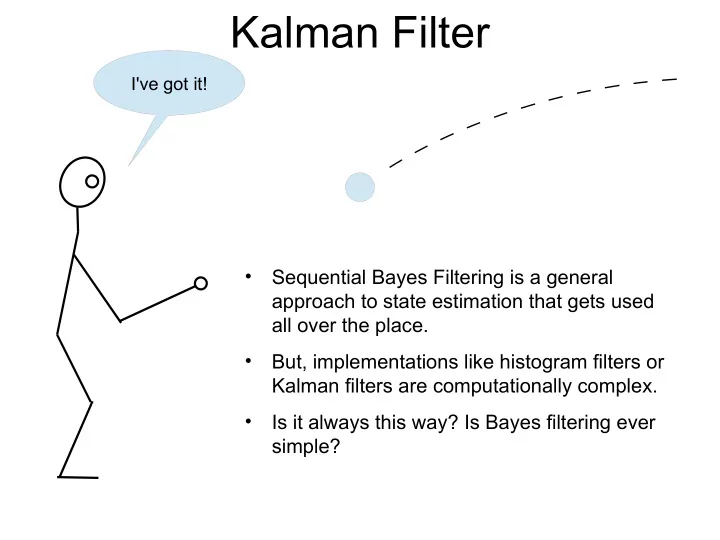

Kalman Filter I've got it! • Sequential Bayes Filtering is a general approach to state estimation that gets used all over the place. • But, implementations like histogram filters or Kalman filters are computationally complex. • Is it always this way? Is Bayes filtering ever simple?
Why Kalman filtering? In general: state estimation Image: Thrun et al. , Probabilistic Robotics Kalman filters are particularly well suited for tracking moving objects Image: UBC, Kevin Murphy Matlab toolbox
Review of sequential Bayes filtering Process update: Measurement update:
Review of sequential Bayes filtering Image: Thrun et al. , Probabilistic Robotics
Transition function Recall the state transition function: Next state Current state – this probability can be expressed as a table: Can also be expressed as a function: or:
Linear system A linear system is any system where: (technically, this is a linear Gaussian system) Also written:
Linear system: Example k m b Equation of motion: How get it into this form?
Linear system: Example k m b Equation of motion: How get it into this form? Integrate forward one timestep:
Linear system A linear system is any system where: (technically, this is a linear Gaussian system) Also written: Also, assume that the observation function is linear Gaussian:
Kalman Idea initial position prediction measurement update y y y y x x x x Image: Thrun et al. , CS233B course notes
Kalman Idea Image: Thrun et al. , CS233B course notes posterior Measurement evidence prior Image: Thrun et al. , CS233B course notes
Gaussians Univariate Gaussian: Multivariate Gaussian:
Playing w/ Gaussians Suppose: Calculate: y y x x
In fact Suppose: Then:
Illustration Image: Thrun et al. , CS233B course notes
And Suppose: Then: Marginal distribution
Does this remind us of anything?
Does this remind us of anything? Process update (discrete): Process update (continuous):
Does this remind us of anything? Process update (discrete): Process update (continuous): Transition dynamics prior
Does this remind us of anything? Process update (discrete): Process update (continuous): Transition dynamics prior
Observation update Observation update: Where:
Observation update Observation update: Where:
Observation update Observation update: Where:
Observation update But we need:
Another Gaussian identity... Suppose: Calculate:
Observation update But we need:
To summarize the Kalman filter System: Prior: Process update: Measurement update:
Suppose there is an action term... System: Prior: Process update: Measurement update:
To summarize the Kalman filter Prior: Process update: Measurement update: This factor is often called the “Kalman gain”
Things to note about the Kalman filter Process update: Measurement update: – covariance update is independent of observation – Kalman is only optimal for linear-Gaussian systems – the distribution “stays” Gaussian through this update – the error term can be thought of as the different between the observation and the prediction
Kalman in 1D System: Image: Thrun et al. , CS233B course notes Process update: Measurement update: posterior Measurement evidence prior Image: Thrun et al. , CS233B course notes
Kalman Idea initial position prediction measurement update x x x x ˙ ˙ ˙ ˙ x x x x next prediciton x ˙ x Image: Thrun et al. , CS233B course notes
Example: estimate velocity prediction past measurements Image: Thrun et al. , CS233B course notes
Example: filling a tank Level of tank Fill rate Process: Observation:
Example: estimate velocity
But, my system is NON-LINEAR! What should I do?
But, my system is NON-LINEAR! What should I do? Well, there are some options...
But, my system is NON-LINEAR! What should I do? Well, there are some options... But none of them are great.
But, my system is NON-LINEAR! What should I do? Well, there are some options... But none of them are great. Here's one: the Extended Kalman Filter
Extended Kalman filter Take a Taylor expansion: Where: Where:
Extended Kalman filter Take a Taylor expansion: Where: Where: Then use the same equations...
To summarize the EKF Prior: Process update: Measurement update:
Extended Kalman filter Image: Thrun et al. , CS233B course notes
Extended Kalman filter Image: Thrun et al. , CS233B course notes
Recommend
More recommend